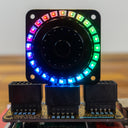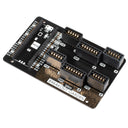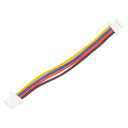RGB Encoder Wheel Breakout
by Pimoroni



Add a stylish navigational aid to your project with our fully assembled ANO scroll wheel encoder breakout!
This cool mechanical encoder has five buttons (up, down, left, right and centre) and a rotary scroll wheel (with satisfying clicky detents). We've surrounded it with 24 twinkly RGB LEDs and turned it into a handy, pre-assembled I2C breakout so it's convenient to incorporate into your Raspberry Pi or Raspberry Pi Pico projects.
It's compatible with our fancy Breakout Garden system, where using breakouts is easy as popping it into one of the slots and starting to grow your project, create, and code. It also has two Qw/ST connectors so it can be easily plugged into microcontrollers and HATs with Qwiic or STEMMA QT connectors, like Cosmic Unicorn 🦄 or Wireless Plasma Kit 💀.
Features
-
Nuvoton MS51 microcontroller (datasheet / Technical Reference Manual)
- ANO Directional Navigation and Scroll Wheel Rotary Encoder (Diagram)
- 24 RGB LEDs driven by an IS31FL3731 driver chip
- I2C interface, with addresses: 0x13 (encoder), 0x77/0x74 (LEDs)
- 3V to 5V compatible
- Reverse polarity protection (on Breakout Garden connector)
- Fully assembled, no soldering required!
- Compatible with Raspberry Pi computers (Python library)
- Compatible with Raspberry Pi Pico (C++/MicroPython libraries)
- Schematic
Includes
- RGB Encoder Wheel breakout
- 1x5 pin header
- 1x5 right-angle socket header
We've designed this breakout board so that you can solder on the piece of right-angle socket header and pop it straight onto the bottom left 5 pins on your Raspberry Pi's GPIO header (pins 1, 3, 5, 7, 9).
Software
There's a easy to use Python library for using this breakout with a Raspberry Pi computer, with examples that use the encoder and LEDs together to make a clock, stopwatch or handy colour picker.
That's not all! You can also use this breakout with Raspberry Pi Pico and our growing selection of RP2040 boards, using C++ or Pirate brand MicroPython.
Notes
- The default I2C address of the encoder is 0x13, but it's possible to change this in software if you'd like to use multiples, or avoid conflicts with other I2C devices. The new address will be saved in flash memory, so will persist if unpowered.
- The I2C address of the LEDs can be changed from 0x77 to 0x74 by cutting the trace on the back of the breakout.
- Fancy a few extra GPIO? We've added pads that can be used to access some spare GPIOs on the Nuvoton / IO Expander. These can be used as inputs and outputs, they're ADC-capable and PWMable and we've also added convenient power and ground pads. Free GPIO, woo!
- Want to make a snazzy diffuser for the LEDs? Here's a .dxf file for laser cutting!
- Dimensions: 48x42x10.5mm (LxWxH, approx). The mounting holes are M2.5 and 34mm apart (centre to centre).
-
RGB Encoder Wheel Breakout
PIM673Out of stock£16.25
Breakout Garden
The easiest way to use breakouts with Raspberry Pi & Pico
-
 Pico Breakout Garden Base+ £11.00
Pico Breakout Garden Base+ £11.00
Qw/ST cables
Connect breakouts to boards compatible with Qwiic & STEMMA QT
-
 4 Pin JST-SH Cable (Qwiic, STEMMA QT, Qw/ST)+ £1.25
4 Pin JST-SH Cable (Qwiic, STEMMA QT, Qw/ST)+ £1.25
Shop with confidence – we've been serving the hobbyist electronics, Maker, and retro gaming communities since 2012.
- Satisfaction or refund guarantee
- Worldwide shipping via mail or courier
- 57,000+ customer reviews
- Secure website and payments


